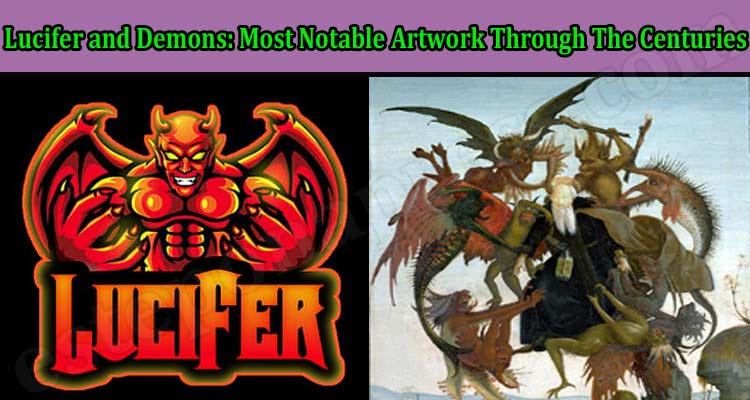Whether you call him the Devil, Lucifer and Demons, Satan, or Mephistopheles, he has more faces than names. Hundreds of artists have depicted Lucifer as a horned, apollo-like demon leader in the last five centuries, but that has changed with time. So how do artists decide what he looks like?
For the longest time, artists took inspiration from fables, the Bible, and their sheer imagination. However, newer depictions represented the devil as more human instead of a beast when compared to 15th and 16th-century art. So let’s have a look at all notable famous demon paintings from various artists that contribute to our imagination when we think of Satan.
The Fallen Angel by Alexandre Cabanel – 1847
The Fallen Angel was among the first Academic paintings showing Lucifer in the most human form art has ever seen. Cabanel took inspiration from the poem by John Milton called Paradise Milton. It shows the moment God cast him out of heaven, and he can be seen reclining against a rock as several angels rejoice and celebrate behind him in the sky.
Teardrops can be seen in his eyes as he attempts to hide his anger and wrath. This fabulous Lucifer painting was heavily criticized in the past but remained the most human-like portrayal of the fallen angel.
Wolfgang and the Devil by Michael Pacher – 1471 to 1475
St. Wolfgang and the Devil by Michael Pacher is a Lucifer Renaissance painting portraying St. Wolfgang standing with the devil. He agrees with the devil to help him build a church, and in return, the devil takes the soul of the first person that steps inside it.
Therefore, this Devil artwork shows a famous legend where ironically, humans are shown to sacrifice things for their good as St Wolfgang, a bishop, made a deal with the devil. The painting illustrates the concept of evil within man and how Satan uses that evil to bring destruction to the world.
The Nightmare by Henry Fuseli – 1781
The Nightmare was Fuseli’s most famous work, stirring a lot of excitement and interest with its subject matter – demon artwork. In the artwork, we can see a woman in her bed who appears to be in a deep sleep. Her limbs are dangling down the bed, and her hair hangs loose. The viewer may quickly spot the peculiar brown figure staring back at them.
The figure appears demon-like and has its left hand pressed to his chin. There has been quite some debate over this painting – from mythological stories about demon intercourse to sleep paralysis. However, the most accepted theory is that of German folklore.
The theory says that a demon called “mara” visits people while they sleep and creates heavy pressure on their chest. Therefore, religious people heavily associate this realistic demon artwork with what happens when they experience sleep paralysis.
Lucifer by Franz von Stuck – 1890
There are only a few things spookier than Satan himself, and Stuck’s depiction of him sits at the top of that list. Stuck’s work depicts subjects like Pluto the Roman God of the Underworld, and Lucifer himself. The artist approaches the idea of symbolism through duality and human nature.
The meaning behind “Lucifer” does not need any explanation. This work by Stuck dates back to his dark monumental art period. In this terrifying satan painting, he depicts Satan as a monster with luminous yellow eyes and black wings.
However, the most notable thing about the piece is the human touch on the mad demon. The painting symbolizes all humans carry evil and do not need any external or supernatural source to lead them astray.
The Last Judgment by Giotto di Bondone – 1306
The Last Judgment is one of the earliest representations of divine judgment, including Jesus Christ, Hell, angels, and demons art. In the painting, angels are blowing trumpets, a sign that signals the arrival of Christ or judgment day. Hell is on the bottom right of the painting, where the evil souls are receiving punishment for their sins.
Giotto has shown hell with rocky ruins and a place that is completely devoid of life. Hell’s punishments involve torture and demons inflicting harm on sinners. There are bodies hanging and dispersed together as a beast with horns, Lucifer, feeds on the damned soul. Furthermore, the souls in hell are conscious through their suffering, an idea that is enough to send chills down the viewer’s spine. It is among the most famous paintings of hell to date.
Final Thoughts
The artists of the renaissance period were interested in combining Greek mythology stories with Christian theology. This blending of two distinct subjects led to many iconic devil paintings and statues depicting the story of Satan and his deeds on Earth.
While the image of the devil as a figure with horns and red wings persists today, artists like Cabanel and Stuck have given a human touch to the damned angel.
Also Read – Is Biomarcia Legit {Aug 2022} Read The Fair Reviews & Find!

